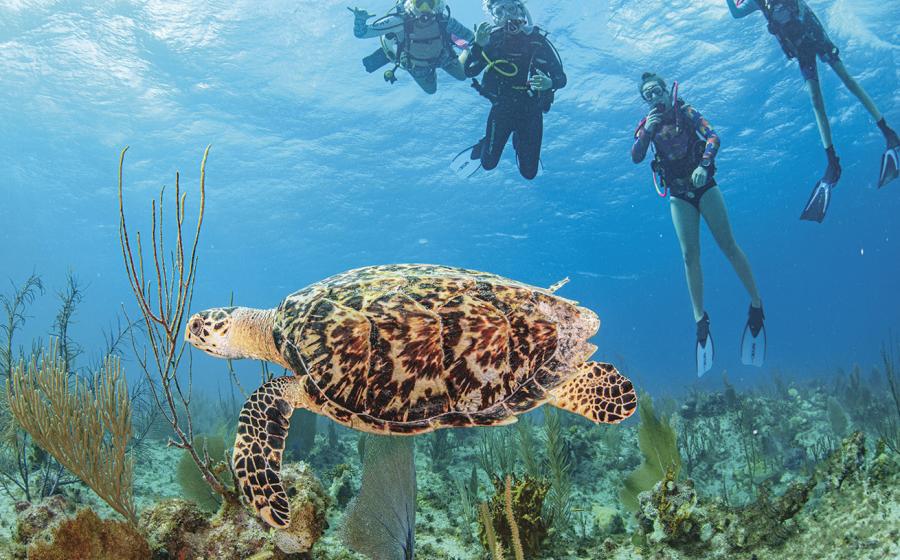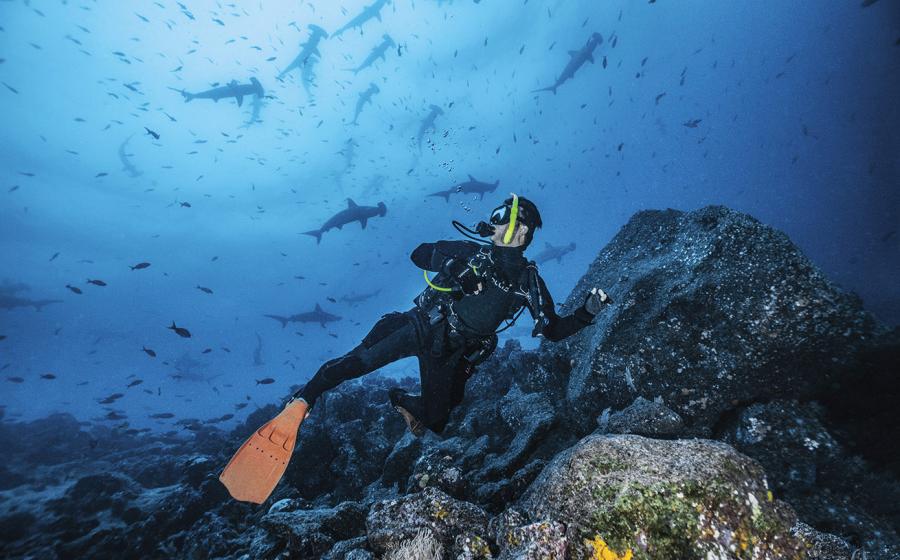More Local Adventures

Ty Sawyer
Alaska: Seldovia Beneath Seldovia's waters, divers will find colorful kelp-covered reefs that are full of fish, 8-foot-long wolf eels, giant Pacific octopus and huge sunflower stars. Nearby is Jakolof Bay, which is also packed full of life.
Arizona: Ringbolt Rapids, Colorado River This unique dive in the exhilarating 54°F water and 5- to 12-knot current of the Colorado River is located a few miles south of the Hoover Dam. Go with a guide, and be sure to bring a hard hat.
Arkansas: Norfolk Lake Natural rock formations like Devil's Backbone, wrecks of all kinds and even the foundations of homes swallowed by the lake when it was dammed in the '40s can be found in the pristine waters of Norfolk Lake. It is home to 29 dive sites within a couple miles of the marina.
Colorado: Aurora Lake Aurora Lake is a bubble-blower haven with a 100-by-100-yard area mapped out just for divers. There's a twin-engine Beechcraft sunk in the lake, creating a nice refuge for the population of perch and crayfish.
Connecticut: Valve Wreck at Fishers Island SoundThis wreck of a small 1900s-era tug sits at 68 feet and is best viewed from April through November. The boat's true name is unknown, but the nickname "Valve Wreck" came from the seemingly endless supply of brass valves that were recovered from the wreck.
Delaware: Washingtonian Schools of tautog and sea bass have made the wreck of the Washingtonian off the coast of Delaware their home. And toward the end of the season, the warm Gulf Stream waters bring sand tiger sharks, butterflyfish and baitfish to the area.
Georgia: Gray's Reef That's right. There's a marine sanctuary in Georgia. It's a mere 17 miles east of Sapelo Island with prolific invertebrate life living along 8- to 12-foot ledges in 60-70 feet of water.
Idaho: Coeur d'Alene Lake This lake boasts more than 200 wrecks ranging in size from a canoe to a 165-foot steamer that are all surrounded by resident pike, bass, sunfish, perch and even a rare sturgeon.
Illinois: Mermet Springs This 8.5-acre spring-fed quarry has sheer 100-foot walls that can be followed to depths of 120 feet. There is also a sunken Boeing 727 that was used in the movie U.S. Marshals. www.mermetsprings.com
Indiana: Sunset Lake This quarry is an old coal-mine strip pit with a school bus, a car, a statue and a few old boats on the bottom. It is a city park in Linton, Indiana, with shallow water and visibility that can be restricted in midsummer due to an algae bloom. The park's entrance fee is $5.
Iowa: Lake Okoboji, Arnolds Park Divers can enjoy 40-plus feet of viz during April and May in this incredible blue-water lake that was formed by a glacier. It is home to rock reefs, bountiful fish life, pipelines and an underwater tower. The lake turns over twice a year (in spring and winter), and visibility drops to 8 to 10 feet.
Kentucky: Dive Cerulean Abandoned in 1952, this 16-acre clear-spring rock quarry has become a popular training site for dive operators. You can explore an old Cadillac and other sunken vehicles as well as a cabin-cruiser wreck. www.divecerulean.com
Maine: Deer Island, Eastport The town of Eastport lies at the edge of Passamaquoddy Bay, an offshoot of the Bay of Fundy, and experiences tidal fluctuations of up to 30 feet. This means that diving must be done at slack tide. Deer Island, which is only an island during high tide, has an amazing vertical wall that drops down to 200 feet. Divers will see hundreds of tealia anemones, pink soft corals, nudibranchs, sea ravens, monster lobsters and much more. You can walk across a seaweed pebble beach to the island during low tide.
Massachusetts: Halfway Rock Halfway Rock has been a crossroads of New England sea travel for 450 years. But below the surface lies a 60-foot vertical drop covered with pastel corals, sponges and anemones. Large pelagics, like sharks and bluefish, are common in the summer as well.
Michigan: ME Tremble, St. Clair River This century-plus-old wooden schooner is difficult to get to, requiring a leap off an 8-foot seawall and traversing an acre of 6-knot river current while avoiding the giant freighters that pass overhead. But it's an action-packed dive that's well worth the trip if you get the right training.
Minnesota: Cuyana Mine Pits There are 50 established dive sites scattered over the 22 open-pit iron-ore mines in the central Minnesota community of Brainerd. And one site, Shangri-La, offers 30-75 feet of viz with a terraced bottom and sheer walls that support a diverse fish population.
Montana: Big Horn Canyon Imagine a smaller version of the Grand Canyon. Now imagine it dammed up. This is the wall diving you will find at Big Horn Canyon National Recreation Area. Access is mostly by boat from Fort Smith.
Nebraska: Lake McConaughyThis is Nebraska's largest reservoir, surrounded by 105 miles of white sand beaches. The two most popular sites are Diver's Cove at the south end of the dam and Burma Bay.
Nevada: Lake TahoeEverything about Lake Tahoe is beautiful and massive. It is surrounded by the Sierra Mountains, and the gin-clear water only warms up to about 60°F in the summer. Many trinkets from the countless number of boaters in the area can be found on the bottom, as well as numerous crayfish.
New Hampshire: Isles of Shoals Isles of Shoals, located eight miles off Portsmouth, New Hampshire, is home to one of New England's premier seal dives at Duck Island. The two largest islands in the nine-island chain, Appledore and Star, boast a marine laboratory and a historic resort.
New Jersey: The Wreck of the Stolt Dagali Only the stern section of the Stolt Dagali can be found in the waters off New Jersey after a collision with the Israeli liner Shalom sheared the vessel in two. It is covered in every encrusting creature that exists in these waters, making it a popular site for divers.
New Mexico: Blue Hole This spring-fed, bell-shaped pool is often referred to as "Nature's Jewel." The visibility can reach 50-100 feet in this 66-foot-wide, 82-foot-deep hole. A permit, which can be purchased at the local police station, is required to dive at this site.
New York: Passenger Liner Oregon This finely appointed passenger liner sank in 1886 when it collided with a schooner south-southwest of Moriches Inlet off Long Island, New York.
North Dakota: Lake Sakakawea Trail Race This unique drift dive is created by water charging through turbines used to generate electricity and exiting first into the man-made riverbed and then into the river. The Trail Race is what connects the two.
Ohio: Gilboa Quarry This is the place to see 5-foot-long paddlefish, toothless filter feeders that were once prized across North America for their meat and caviar and now thrive only in a few locations. There is also a Grumman airplane and several boats to explore.
Oklahoma: Lake Tenkiller Divers will find a variety of options at the lake in Tenkiller State Park, including shore access, gentle slopes, deep walls (up to 120 feet), four islands accessed only by boat and an underwater terrain that includes ledges and trees.
Oregon: Clear Lake As the name suggests, the visibility is incredible in Clear Lake. There is a complete sunken forest, algae fields that cover the bottom like meadows and strange geothermal vents that emit a milky substance.
Pennsylvania: Dutch Springs Dutch Springs, in the Lehigh Valley of Pennsylvania, is a flooded limestone quarry that is now a 47-acre diving attraction. Highlights include a plane, a helicopter, a fire engine and a trolley.
Rhode Island: U-853 The U-853, the last German U-boat sunk during World War II, can be found in 130 feet of water off Block Island, Rhode Island. The hull remains largely intact, but there are several holes for experienced divers to penetrate.
South Carolina: Cooper River This is one of the richest marine-fossil beds in the world. Here, divers will find giant fossilized shark teeth, including the granddaddy of all sharks, megalodon at 50 feet in length, the largest shark to ever swim the Earth.
South Dakota: Pactola Lake The town of Pactola, a historic mining town from the 1800s, lies below the surface of Pactola Lake in South Dakota. The town was flooded when a dam was built in Rapid City in 1956.
Tennessee: Dale Hollow Lake This lake is the most popular site for Tennessee divers. They can explore the old schoolhouse foundation and other town remnants that have become habitats for largemouth bass and bluegill.
Utah: Homestead Crater The crater is a 60-foot-deep geothermal pool in a beehive-shaped dome with an opening to the sky. The 90-96°F ever-so-slightly carbonated water is like a spa treatment, and access is through a 100-foot tunnel dynamited into the base of the crater. www.homesteadresort.com
Vermont: General Butler The General Butler is an 88-foot lake vessel at the south end of the Burlington Breakwater. This rare example of a sailing canal boat could sail across the lake, but with masts removed and center board raised, it could also traverse the Champlain Canal.
Virginia: Lake Rawlings This 20-acre quarry-turned-scuba park has a granite rock bottom that keeps visibility at 30-50 feet. Divers can explore a school bus, a cabin cruiser, a shrimp boat and a sailboat hull from the movie The Replacements.
Washington: Keystone Jetty, Whidbey Island This 250-foot-long jetty is comprised of boulders that slope down to nearly 60 feet at the end. Divers will find giant Pacific octopi, huge beds of plumrose anemones and assorted invertebrates.
Wisconsin: Prins Willem V Affectionately called the "Willy," this site lies three miles off the coast of Milwaukee and is one of Lake Michigan's most popular wrecks. It is a 258-foot Dutch freighter that now lies on its side in 90 feet of water.
Wyoming: Firehole River The trick to this dive is for divers to work their way into the channel and the main flow of the current. They will then move toward two holes where trout school and swimmers leave behind many mementos. The river is fed by the geothermally heated water and is best to dive in late summer.






